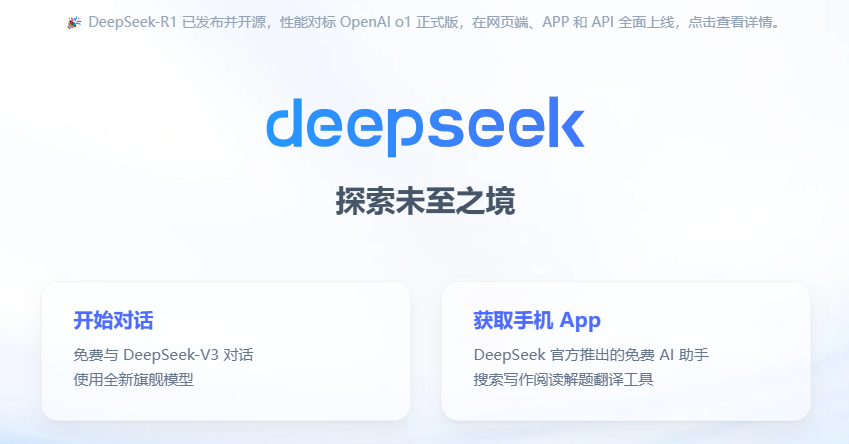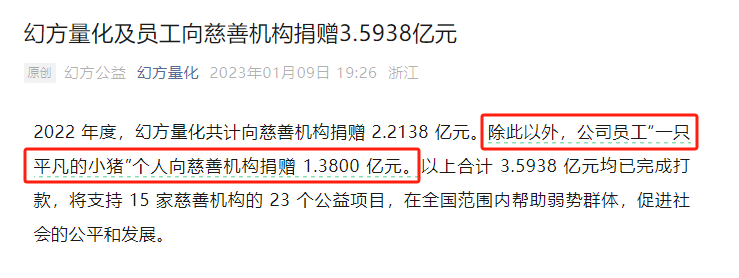Returning Town Youth's Legacy: DeepSeek's Grassroots AI Carnival
![]() 02/08 2025
02/08 2025
![]() 572
572

Source | YuanMeiHui
This Spring Festival, domestic AI unicorn DeepSeek captured the spotlight in unprecedented fashion.

Screenshot from DeepSeek's official website
DeepSeek's sudden fame attracted hordes of tourists to Mililing Village in Tanba Town, Wuchuan, Zhanjiang, Guangdong—the hometown of its founder Liang Wenfeng. They came to "check in," and even feng shui masters used compasses to study the layout of houses in Mililing and Liang's residence. For a moment, technology merged seamlessly with metaphysics.
Amidst a flurry of investments by domestic and international giants in the AI large model market, DeepSeek, a large model company nurtured by quantitative private equity firm QuantOpt (hereinafter referred to as "QuantOpt"), boasts a core team of just over 100 individuals. Without grand press conferences, it has quietly penetrated the market with its reputation for being "usable, easy-to-use, and affordable."
DeepSeek's rise not only caused a significant decline in U.S. tech stocks but also sparked a price war within the industry.
Liang Wenfeng himself has become a beacon in China's AI field, known for his generosity in donating hundreds of millions of yuan and his refusal to bow to capital pressures.
01
A "Silent" Technological Revolution
Unlike most AI companies that rely on capital to "create momentum," DeepSeek's popularity during the Spring Festival was deeply rooted in "grassroots" characteristics.
This is evident in two key aspects:
First, technology democratization. For instance, DeepSeek's open-source 7B small model can run on Intel Xeon CPUs, enabling AI teaching in county middle schools using outdated computer labs and even allowing county programmers to debug code using it. Additionally, DeepSeek's open-source mathematical reasoning model has been integrated into the business systems of small and medium-sized technology companies.
Second, ultimate cost-effectiveness. For example, the API call prices for models like DeepSeek-R1 and DeepSeek-V3 are as low as 0.14 yuan per 10,000 tokens, just 1/20th of the industry average. An agricultural product e-commerce company in Henan has reduced its intelligent customer service costs by 92% by adopting these models.
Supporting DeepSeek's "ultimate cost-effectiveness" is the survival philosophy honed by QuantOpt from quantitative trading—the self-developed "dynamic computation graph" technology. This allows the same batch of GPUs to train three models in parallel, achieving a hardware utilization rate of 89%, far surpassing the industry average. The introduction of quantitative risk control models for training data cleaning raises the invalid data labeling rate to 93%, and the training cost of the 10 billion-parameter model is kept within 8 million yuan.
Unlike large companies fixated on the trillion-parameter race, DeepSeek focuses on enhancing "unit computing power output efficiency." Its 13B-parameter model outperformed several hundred-billion-level large models in legal document review scenarios, core to its precise understanding of contract terms and industry terminology—a testament to the QuantOpt team's experience in processing financial legal texts over the years.
Moreover, Liang Wenfeng insists on "funding AI research and development with money from quantitative trading." He has stated that QuantOpt, as an investor, has ample research and development budgets, alongside a yearly donation budget of several hundred million yuan previously earmarked for public welfare organizations, which can be adjusted as needed. Some analysts also note that QuantOpt invests 90% of its annual net profit in technological breakthroughs, with team members even voluntarily converting their year-end bonuses into research and development funds.
This model avoids the pursuit of short-term capital gains but carries risks—fluctuations in China's A-share market in 2023 led to a 18% year-on-year decrease in QuantOpt's research and development funds, forcing the team to halt two long-term projects.
02
The First Pot of Gold and the Confidence of "Not Being Short of Money"
Founded in 2016, QuantOpt began as a low-key quantitative private equity fund in Hangzhou with a team of fewer than 20 individuals but achieved repeated revenue miracles in the secondary market leveraging AI algorithms.
QuantOpt's wealth was initially generated through quantitative trading. Liang Wenfeng's team developed a high-frequency trading system based on machine learning in the early years, achieving a 300% annualized return against the trend during China's A-share market fluctuations in 2015, rapidly accumulating billions of capital.
By 2022, QuantOpt's management scale had surpassed 100 billion yuan, making it one of Asia's largest quantitative private equity funds. That same year, QuantOpt and its employees donated approximately 360 million yuan to charitable organizations, with one employee contributing 138 million yuan personally. This donor has been identified as Liang Wenfeng by the public.

Image source: QuantOpt official account
Liang Wenfeng, who is "not short of money," has publicly stated on multiple occasions: "QuantOpt does not need financing, and the money we earn is sufficient to support innovation."
Subsequently, Liang Wenfeng's team transferred the accumulated AI technology from the quantitative field to the large model track, establishing DeepSeek, which soared to the second tier of the global large model arena in just three years, competing alongside giants like Google and Meta.
According to Tianyancha, Hangzhou DepthSeek Artificial Intelligence Basic Technology Research Co., Ltd. (hereinafter referred to as "DepthSeek") was established in 2023, with Ningbo Cheng'en Enterprise Management Consulting Partnership (Limited Partnership) and Liang Wenfeng holding 99% and 1% of the shares, respectively. The former is also a holding company of Liang Wenfeng. The operating entity of DeepSeek is DepthSeek.
Compared to OpenAI's team of thousands and a $10 billion investment, DeepSeek's core team comprises just over 100 individuals, with research and development costs less than 1/10th of those of industry giants. Its open-source model DeepSeek-Math surpasses GPT-4 in the GSM8K mathematical reasoning test, with an API price just 1/50th of GPT-4's. This "ultimate cost-effectiveness" directly impacts the market, forcing companies like Alibaba and Baidu to lower their prices in response.
Behind DeepSeek's rise lies an almost "fanatical" investment in technology.
Luo Fuli, one of the key developers of DeepSeek's open-source large model DeepSeek-V2, who was once recruited by Xiaomi founder Lei Jun with a salary of tens of millions of yuan and hailed as the "genius AI girl," once bluntly stated: "At QuantOpt, the technical ideal is more attractive than commercial returns."
DeepSeek's rise indirectly highlights the current dilemma of the domestic chip industry.
03
China Needs 100 DeepSeeks
"The issue with China's AI chips isn't the manufacturing process but the ecosystem."
"If we can enhance the algorithm efficiency of domestic chips by 30%, we can create a significant gap," Liang Wenfeng said in a recent CCTV interview.
To avoid restrictions from NVIDIA, DeepSeek uses Huawei's Ascend 910B to train models, but operator compatibility issues reduce training efficiency by 40%, necessitating 30% of the engineers' manpower to develop conversion tools. Liang Wenfeng believes this should be the responsibility of chip manufacturers.
Additionally, some industry insiders argue that if China's AI only makes incremental improvements based on NVIDIA chips and OpenAI papers, it amounts to another form of outsourcing.
While most companies are anxious about "when to create a Chinese version of GPT-4," QuantOpt redefines the dimension of competition with a mathematical mindset—not being enslaved by parameter scale but instead focusing on "inputting 1 kWh of electricity and outputting 10 times the intelligence."
As the industry is captivated by capital stories, QuantOpt proves that it's not a fairy tale to support the "slow research and development" of hard-core technology with the "fast money" from quantitative trading.
While the world chases the Holy Grail of Artificial General Intelligence (AGI), China may need 1,000 "specialized intelligences" that deeply transform manufacturing, agriculture, and small and micro-enterprises.
On the first day after the Spring Festival holiday, a highly praised message appeared in the DeepSeek community: "The county programmers in our county have received three orders using your model, supporting a small team of five people." This embodies the true vitality of China's AI—not in the headlines of financing news but in the details of countless ordinary people leveraging technology to improve their lives.
As global AI is caught in a "arms race" involving tens of billions of dollars, Liang Wenfeng and QuantOpt present an anti-mainstream narrative—using the ultimate rationality of mathematicians, the pragmatic innovation of engineers, and nearly obsessive cost control to prove that "smart capital" and "technological idealism" can indeed coexist.
This may be the key to breaking the deadlock in China's AI: not needing another OpenAI but needing 100 DeepSeeks.
Cold pragmatism, or the future of domestic AI.
Some images are sourced from the internet. Please inform us if there is any infringement for prompt removal.





